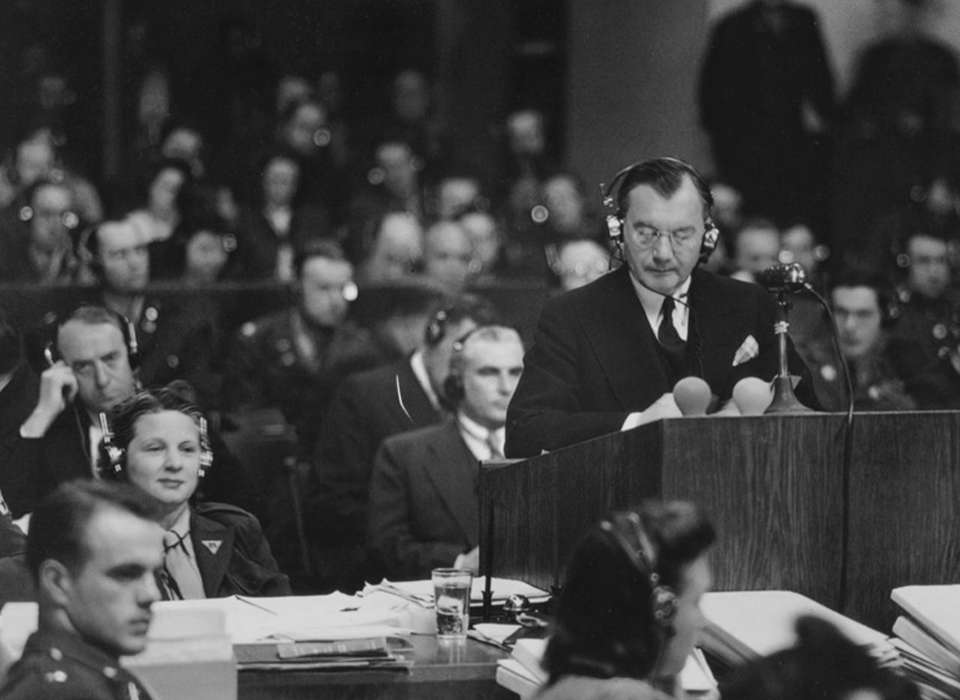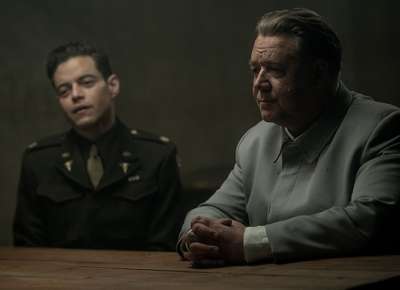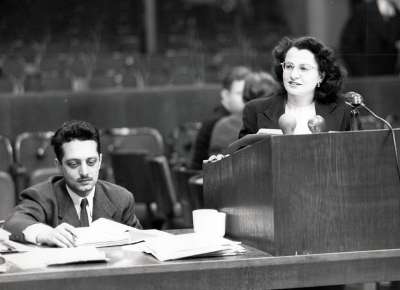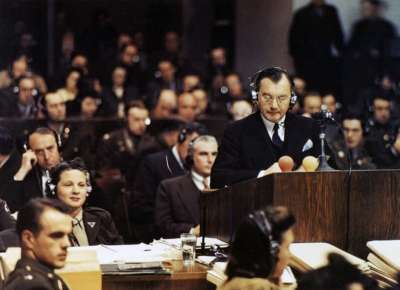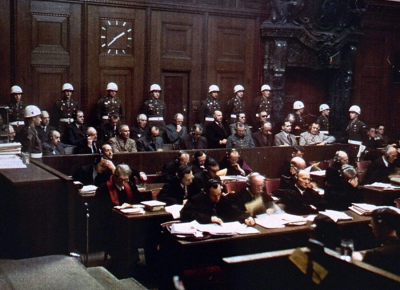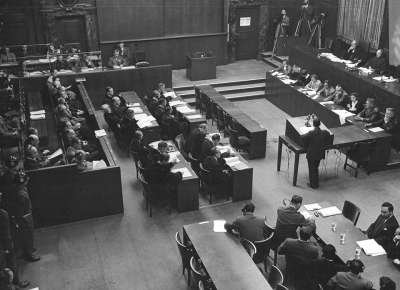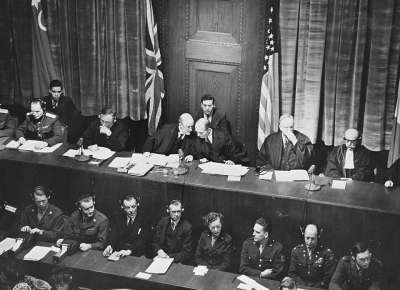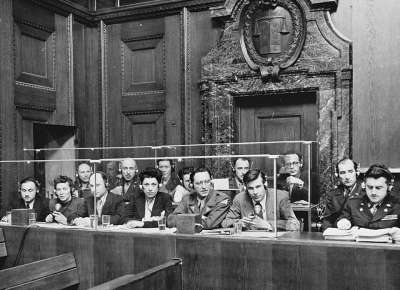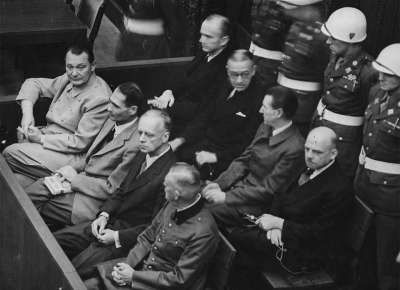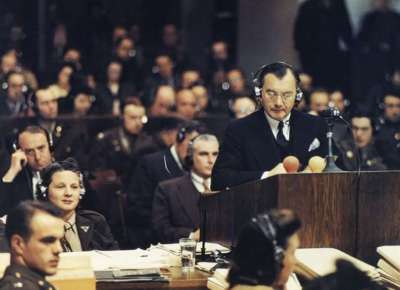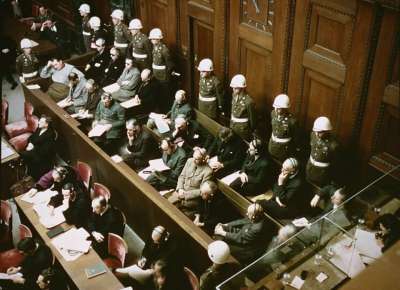Overview:
At the Moscow Conference on October 30, 1943, President Franklin D. Roosevelt, British Prime Minister Winston Churchill, and Soviet Premier Joseph Stalin signed the Declaration of Atrocities, which stated:
"The United Kingdom, the United States and the Soviet Union have received from many quarters evidence of atrocities, massacres and cold-blooded mass executions which are being perpetrated by Hitlerite forces in many of the countries they have overrun . . . those German officers and men and members of the Nazi party who have been responsible for or have taken a consenting part in the above atrocities, massacres and executions will be sent back to the countries in which their abominable deeds were done in order that they may be judged and punished according to the laws of these liberated countries and of free governments which will be erected therein..."
In March 1945, the four major Allied powers proposed trying leading Nazi war criminals before a special international court. Nuremberg, Germany was chosen as the location of the trials for being a focal point of Nazi propaganda rallies leading up to the war. The Allies wanted Nuremberg to symbolize the death of Nazi Germany. At the International Military Tribunal (IMT), which lasted from November 1945 to October 1946, 21 of the 24 indicted Nazi leaders stood trial for crimes against peace, war crimes, crimes against humanity, and conspiracy to commit these crimes. The court convened in the Palace of Justice in Nuremberg, which was previously expanded by German prisoners to fit up to 1,200 detainees. The United States held 12 additional trials in Nuremberg after the IMT. In all, 199 defendants were tried, 161 were convicted, and 37 were sentenced to death.
International Military Tribunal
Appointing the Court
In the days before Germany surrendered on May 8, 1945, President Harry S. Truman appointed Associate Supreme Court Justice Robert H. Jackson to be the chief prosecutor representing the United States in the proposed trials for the European Axis powers. Jackson helped lead the Allies to an agreement called the London Charter, which established the procedures for the Nuremberg Trials. The Charter created the International Military Tribunal (IMT) and was signed on August 8, 1945.
The indictment of 24 Nazi government officials and organizations was filed on October 18, 1945, by the four chief prosecutors of the International Military Tribunal: Robert H. Jackson of the United States, Sir Hartley Shawcross of Great Britain, Francois de Menthon of France, and Roman A. Rudenko of the Soviet Union. The jurisdiction of the Tribunal included crimes against peace, war crimes, and crimes against humanity. Lord Justice Geoffrey Lawrence of Great Britain served as the court’s presiding judge. The proceedings, held in English, were simultaneously translated into French, Russian, and German. The IMT made history as the first of its kind to have judges from four countries presiding.
List of Judges
- Francis Biddle (American)
- John J Parker (American)
- Edward Francis Carter (American)
- Colonel Sir Geoffrey Lawrence, Lord Justice (British, President of the Tribunal)
- Sir Norman Birkett (British)
- Henri Donnedieu de Vabres (French)
- Robert Falco (French)
- Major General Iona Nikitchenko (Soviet)
- Lieutenant Colonel Alexander Volchkov (Soviet)
List of Chief Prosecutors
- Associate Justice Robert H Jackson (United States)
- Attorney General Sir Hartley Shawcross (United Kingdom)
- Francois de Menthon, later replaced by Auguste Champetier de Ribes (France)
- Lieutenant General Roman Andreyevich Rudenko (Soviet Union)
The indictment was read on November 20, 1945, with 21 defendants appearing in court. Top Nazi leaders Adolf Hitler, Joseph Goebbels, and Heinrich Himmler committed suicide prior to the IMT, so they could not stand trial. Of the 24 indicted Nazis at the IMT, Hermann Göring and Robert Ley committed suicide the day before the trial.
From November 20, 1945, to October 1, 1946, the Tribunal tried 24 of the most important military and political leaders of the Third Reich and heard evidence against 21 of the defendants. During the trial, the Tribunal—and the world—learned about the Nazi Party and its "planning, initiating and waging of aggressive war" from the beginning. The court showed footage of Nazi concentration camps taken by Allied military photographers during liberation. The graphic scenes of what took place in Europe were the most powerful evidence against the Nazis presented at the trial. Other memorable moments of the trial were the screenings of the Nazi Concentration and Prison Camps and The Nazi Plan films, the detailed description of the Final Solution, the murders of prisoners of war, atrocities in extermination camps, and countless cruel acts to prosecute Jews.
On October 1, 1946, the Tribunal convicted 19 of the defendants and acquitted three. Of those convicted, 12 were sentenced to death. Three defendants were sentenced to life imprisonment and four to prison terms ranging from 10 to 20 years. On October 16, executions were carried out by hanging in the gymnasium of the courthouse. In 1947, the prisoners sentenced to incarceration were sent to Spandau Prison in Berlin.
List of Defendants
- Martin Bormann
- Karl Dönitz
- Hans Frank
- Wilhelm Frick
- Hans Fritzsche
- Walther Funk
- Hermann Göring
- Rudolf Hess
- Alfred Jodl
- Ernst Kaltenbrunner
- Wilhelm Keitel
- Gustav Krupp von Bohlen und Halbach
- Robert Ley
- Konstantin von Neurath
- Franz von Papen
- Erich Raeder
- Joachim von Ribbentrop
- Alfred Rosenberg
- Fritz Sauckel
- Hjalmar Schacht
- Baldur von Schirach
- Arthur Seyss-Inquart
- Albert Speer
- Julius Streicher
List of Organizations
- The Secret State Police (Gestapo)
- The Protection Squad (SS)
- The Reich Cabinet
- The Leadership Corps of the Nazi Party
- The Stormtroopers (SA)
- The Security Service (SD)
- The General Staff and High Command of the German Armed Forces.
Subsequent Nuremberg Trials
From December 1946 to April 1949, twelve additional military tribunals for war crimes against Nazi Germany leaders were held by the United States in the Palace of Justice. The defendants included 177 high-ranking physicians, judges, industrialists, SS commanders and police commanders, military personnel, civil servants, and diplomats. The trials uncovered the German leadership that supported the Nazi dictatorship. Of the 177 defendants, 24 were sentenced to death, 20 to lifelong imprisonment, and 98 other prison sentences. Twenty-five defendants were found not guilty. Many of the prisoners were released early in the 1950s because of pardons. Thirteen of the 24 death sentences were executed.
Additional Nuremberg Trials
- Doctors' Trial
- Milch Trial
- Judges' Trial
- Pohl Trial
- Flick Trial
- IG Farben Trial
- Hostages Trial
- RuSHA Trial
- Einsatzgruppen Trial
- Krupp Trial
- Ministries Trial
- High Command Trial
